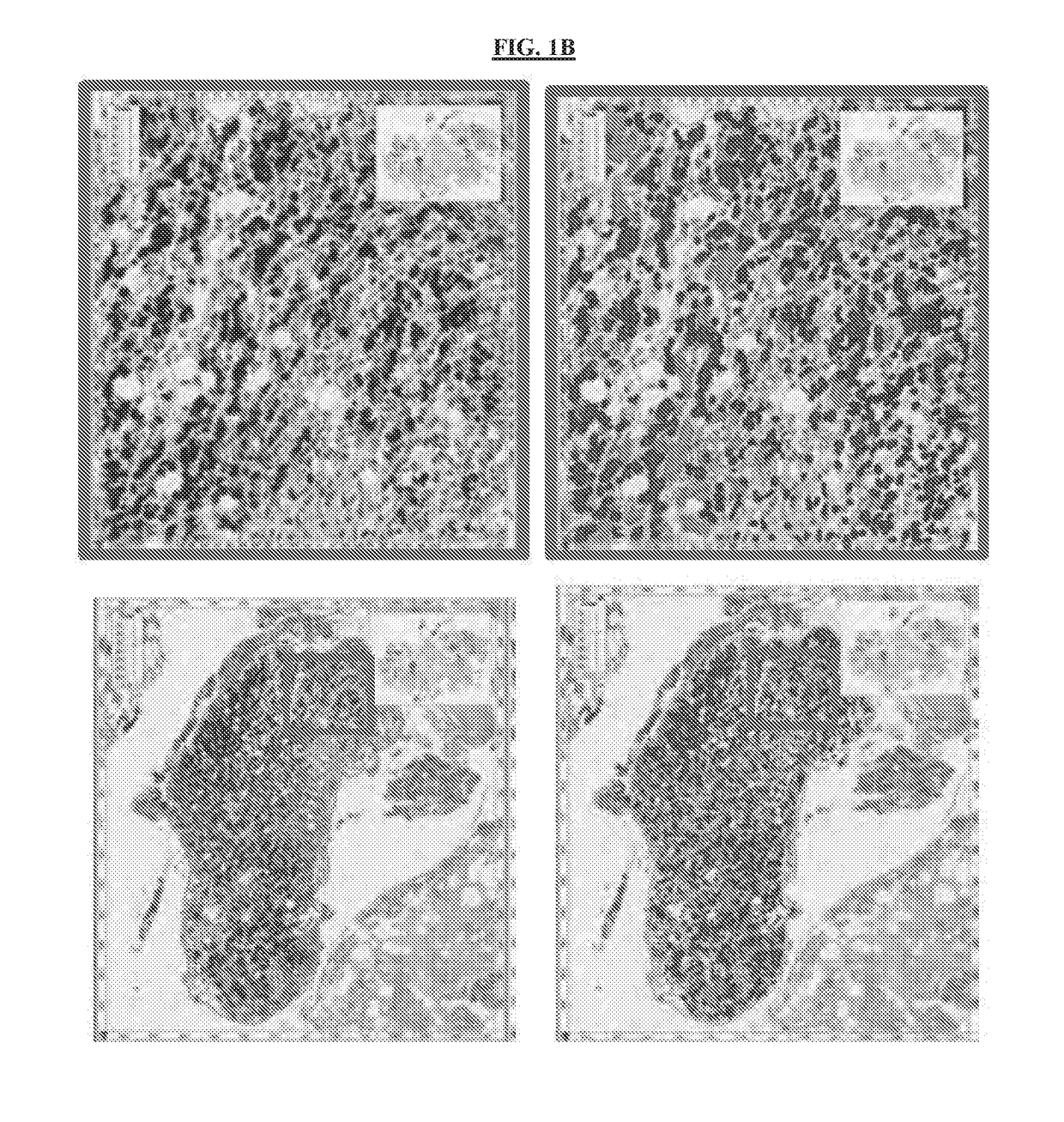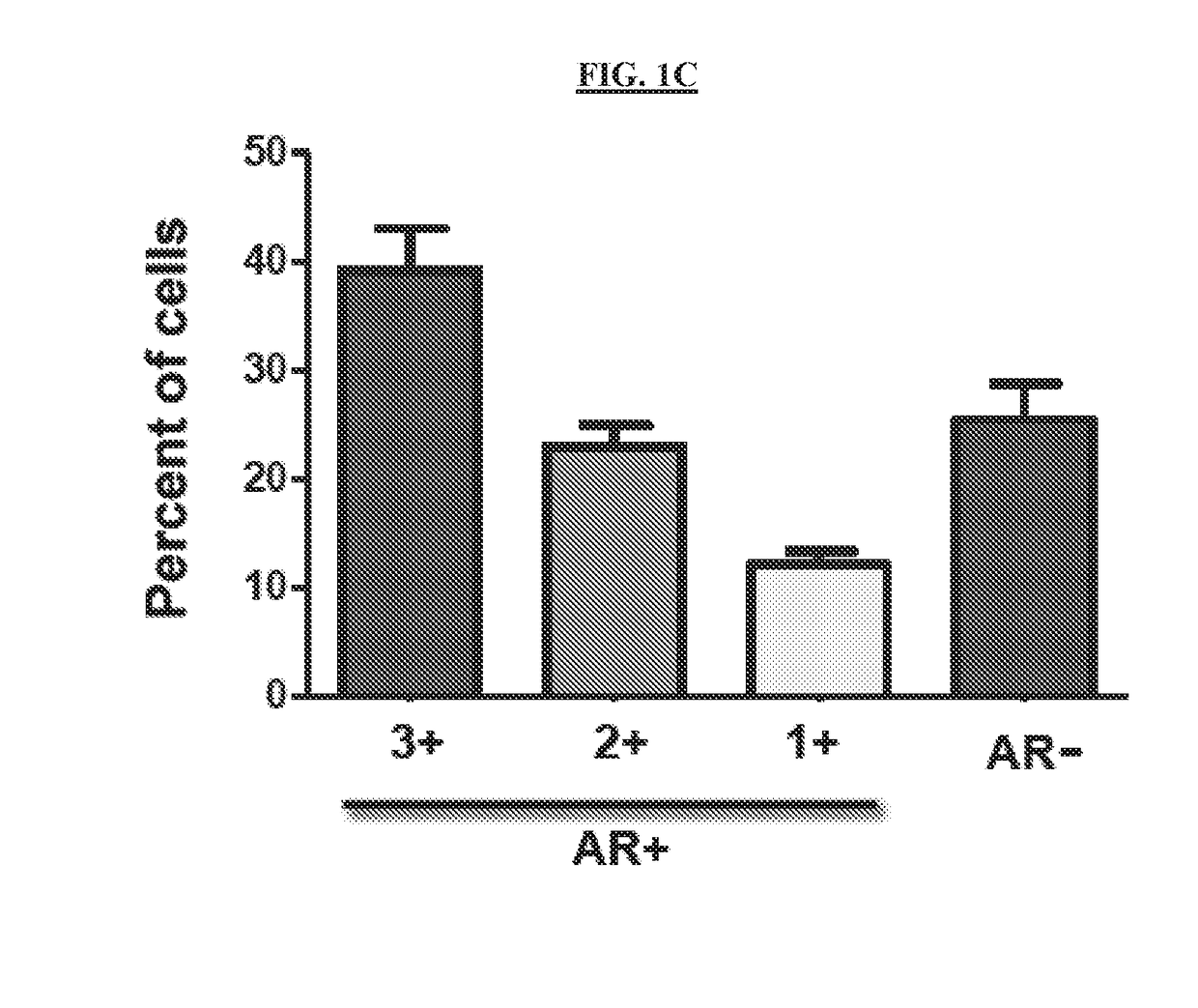Compounds and compositions useful for treating or preventing cancer metastasis, and methods using same
a technology applied in the field of compounds and compositions useful for treating or preventing cancer metastasis, can solve the problems of malignant phenotype formation of putative cancer stem cells, difficulty in urination, problems during sexual intercourse, etc., and achieve the effect of treating or preventing bone metastasis of the cell in the subject and preventing cell growth
- Summary
- Abstract
- Description
- Claims
- Application Information
AI Technical Summary
Benefits of technology
Problems solved by technology
Method used
Image
Examples
example 1
n of Androgen Receptor in Prostate Cancer Cells
[0231]As demonstrated in FIG. 1A, prostate cancer cells lacking the expression of the Androgen Receptor (AR) were detected in metastatic lesions at the skeletal level. The signal generated by the immunochemistry detection of a primary antibody against AR (1-20 amino acids, custom made by Bethyl Laboratories) was used to establish the percentage of AR (+) and AR(−) cells using the Aperio Imaging and analysis suite (FIG. 1B). The present data showed that metastatic lesions include approximately one third of AR(−) cells (FIG. 1D).
[0232]In order to assess the AR status of PCa cells colonizing the skeleton, we examined archival bone biopsies obtained from nine patients in two different clinical cohorts and with documented post-ADT metastatic CRPC. These specimens revealed remarkable variability of AR staining, ranging from lowest to highest signal intensity even within individual lesions (FIG. 1L), while in some areas the AR could be detecte...
example 2
tion of Castration-Resistant Prostate Cancer
[0234]The emergence of AR(−) prostate cancer cells is considered a late event in the clinical history of prostate cancer and occurring as a consequence of Androgen-Deprivation Therapy (ADT). Patients that have received local treatments for their prostate tumors (surgery and / or radiation therapy) are monitored for Prostate Specific Antigen (PSA) in the blood. If the extremely low levels of PSA following local treatment are found to increase, this is defined as “biochemical failure” and associated with a recurrence of the prostate neoplasia. In the absence of evidence for local recurrence, it is then assumed that the patient has distant microscopic recurrences even in the absence of evident metastatic disease. At this point, several measures are undertaken to bring the levels of circulating androgens to castrate-like levels, in an attempt to counteract the translational activity of the AR, which depends on androgens and fuels the growth of p...
example 3
L1β in Survival and Proliferation of AR(−) Prostate Cancer Cells
[0236]The present experiments underline the importance of IL1β in promoting survival and proliferation of AR(−) prostate cancer cells in bone. Anakinra is an antagonist of the receptor for IL1β (IL1R). As demonstrated in FIGS. 3A-3E, in an animal model anakinra significantly impaired the progression at the skeletal level of human prostate cancer cells inoculated in the systemic blood circulation of mice via the left cardiac ventricle.
[0237]The results obtained with anakinra are similar to those obtained by silencing the expression of IL1β in cancer cells (4th column in FIG. 3A). To ascertain whether anakinra blocks the IL1R located on cancer cells or expressed by stromal cells, a mouse colony of SCID mice also knocked out for IL1R was developed ex novo. As shown in FIGS. 3C-3E, in IL1R knock out animals AR(−) / IL1b(+) prostate cancer cells were dramatically affected in their metastatic progression in the bone. This resul...
PUM
| Property | Measurement | Unit |
|---|---|---|
| w/w | aaaaa | aaaaa |
| time | aaaaa | aaaaa |
| time | aaaaa | aaaaa |
Abstract
Description
Claims
Application Information
 Login to View More
Login to View More - R&D
- Intellectual Property
- Life Sciences
- Materials
- Tech Scout
- Unparalleled Data Quality
- Higher Quality Content
- 60% Fewer Hallucinations
Browse by: Latest US Patents, China's latest patents, Technical Efficacy Thesaurus, Application Domain, Technology Topic, Popular Technical Reports.
© 2025 PatSnap. All rights reserved.Legal|Privacy policy|Modern Slavery Act Transparency Statement|Sitemap|About US| Contact US: help@patsnap.com



